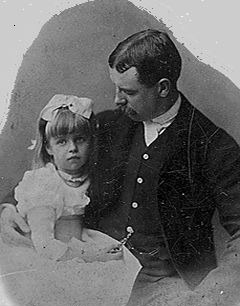|
J. William T. "Bill" Youngs, Eleanor Roosevelt: A Personal and Public Life, Chapter One
|
"Elliot Roosevelt and His Children" courtesy of the Wiki Commons
|
My father...married Anna Hall, and, as is so often the case in life, tragedy and happiness came walking on each other's heels.
- Eleanor Roosevelt, This is My Story
- Eleanor Roosevelt, This is My Story
Chapter 1: A Victorian Family |
SummaryThe Victorian Age in which Eleanor Roosevelt was born into had very rigidly defined social norms. Some adapted to those set roles better than others. This chapter looks at Elliot and Anna Roosevelt, Eleanor's parents, as they tried to fit into the cultured life of the aristocracy near the end of the 19th century.
|
Author reads from the Text
Husband and wife, each with a role to perform in the ideal Victorian family: Anna suited the picture well. Her spirituality was so refined that she had sublimated her encounter with Elliot on the last night at Tivoli into a religious experience. Her friends' statements about her sound like descriptions of a Victorian saint: "She ever strove to be faithful to God"; she was "the light of her home"; "her virtues were most truly womanly in being little known to the outside world"; she "grew into a lovely and noble womanhood."
Anna fit the mold of Victorian respectability, but Elliot did not. He simply could not apply himself to his work. His problem was not uncommon in Victorian America. Ministers, journalists, and politicians might praise the spirit of "rugged individualism," but many men lacked the willpower to play the aggressive "manly" role. This difficulty was so widespread that in 1880 a New York neurologist, George Miller Beard, invented a new disease that he called "neurasthenia." Its symptoms included insomnia, fear of responsibility, desire for stimulants and narcotics, morbid self-consciousness, and above all paralysis of the will. Miller attributed the disease to the peculiar tensions of industrial culture, especially to "constant inhibition. restraining normal feelings, keeping back, holding in check atomic forces of the mind and body."
Elliot showed many of the symptoms of "neurasthenia." His inability to succeed man have reflected a personality that simply was not made for the business world; he may have had to restrain to many "normal feelings." His greatest success lay in personal relations. He was loved for his spontaneous goodwill and kindness. He liked flowers and enjoyed giving them to friends. His sister, Corinne, credited him with "a devotion which was so tender that it was more like that of a woman."
Anna fit the mold of Victorian respectability, but Elliot did not. He simply could not apply himself to his work. His problem was not uncommon in Victorian America. Ministers, journalists, and politicians might praise the spirit of "rugged individualism," but many men lacked the willpower to play the aggressive "manly" role. This difficulty was so widespread that in 1880 a New York neurologist, George Miller Beard, invented a new disease that he called "neurasthenia." Its symptoms included insomnia, fear of responsibility, desire for stimulants and narcotics, morbid self-consciousness, and above all paralysis of the will. Miller attributed the disease to the peculiar tensions of industrial culture, especially to "constant inhibition. restraining normal feelings, keeping back, holding in check atomic forces of the mind and body."
Elliot showed many of the symptoms of "neurasthenia." His inability to succeed man have reflected a personality that simply was not made for the business world; he may have had to restrain to many "normal feelings." His greatest success lay in personal relations. He was loved for his spontaneous goodwill and kindness. He liked flowers and enjoyed giving them to friends. His sister, Corinne, credited him with "a devotion which was so tender that it was more like that of a woman."

